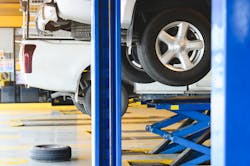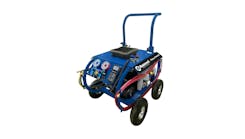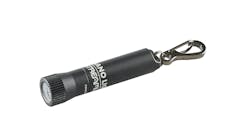This article was updated from its 2021 version.
For any facility tasked with maintaining and repairing vehicles, it is essential to select the proper lifting equipment for maximum efficiency. This is true for small, two-bay light duty repair shops all the way up to large trucking and heavy duty equipment facilities.
“When selecting a lift, a shop must first consider the type of service being provided,” says Peter Bowers, technical sales support manager at Stertil-Koni. “For example, if quick preventative maintenance services are paramount and turnaround time is vital, platform lifts are ideal [because] they deliver speedy, easy access to vehicles.”
He adds, if a shop is more likely to book heavy repairs such as engine and transmission removals, they might benefit more from inground lifts with wheels-free lifting and unrestricted undercarriage access.
“The size and weight of the vehicles being serviced must also be carefully considered,” Bowers says. “A platform lift must be of suitable length with adequate capacity. When opting for an inground lift, axle loads and weight distribution front/rear must be considered to ensure lifting capacities are sufficient. That’s why heavy duty vehicle lifts with automatic synchronization systems to ensure smooth lifting and lowering are vital.
“Finally, don’t forget to measure overhead clearance. The lift should be able to lift the tallest vehicle in your fleet to full height without concern.”
The Automotive Lift Institute (ALI) is an independent certification organization that provides safety and testing for the automotive lift industry in the U.S. and North America. On its site, ALI reminds shop owners that no lift is one-size-fits-all, which is why most general shops need to install more than one of these seven lift types:
1. Two-post surface mounted lifts
2. Multi-post runway lifts
3. Drive-on parallelogram lifts
4. Scissor lifts
5. In-ground lifts
6. Wheel engaging mobile units (Mobile columns)
7. Low/mid-rise frame engaging lifts
Two-post surface mounted lifts
Two-post surface mounted lifts are a common sight in automotive repair shops. The versatile option can handle nearly all vehicle lifting applications and allows for full access underneath light and medium duty vehicles, which is a great help to technicians preforming general maintenance work.
Two-post lifts are usually frame-engaging and have swing arms which travel up the two columns. Two-post lifts are synchronized mechanically, hydraulically, or electronically. A variety of accessories and adapters allow for different functions, such as wheel-engaging operation. ALI offers this safety tip for two-post surface mounted lifts: “To provide support, always lower the lift onto the load-holding devices. Some two-post lifts are equipped with an overhead shut-off bar.”
Multi-post runway lifts
Multi-post runway lifts allow vehicles to be driven onto two runways and lifted by the tires, providing technicians with full access to the underside of a vehicle. These lifts can also be configured for wheels-free service, if needed. It’s another versatile option for many shops, including those that maintain heavy duty vehicles and fleets.
Multi-post runway lifts are commonly configured as four-post surface mounted lifts, according to ALI.
Drive-on parallelogram lifts
This type of lift can be used to service medium to heavy duty, off-highway equipment. Some drive-on parallelogram lifts can be configured to perform wheels-free services.
According to ALI, “Traditional parallelogram lifting mechanisms move the vehicle a short distance fore or aft when lifting or lowering. Most parallelogram lifts are drive-on lifts with two runways. Some hybrid versions of this lift type move straight up and down.”
Parallelogram lifts are powered by an electro-hydraulic power unit. Synchronization of the two parallel runways is usually accomplished by hydraulic or electronic means. Sometimes a torsion bar connected to opposing parallelogram legs is employed to assist in synchronization.
Scissor lifts
Scissor lifts may be equipped as a drive-on style with runways, or as a lift that is frame- or body-engaging. “The scissors lift has a lifting mechanism similar to a traditional parallelogram lift, however, it lifts and lowers a vehicle in a straight vertical path, rather than fore or aft of its original position,” ALI says. Scissor lifts are often found in low-ceiling garages, as they offer ample space to work.
Many scissor lifts permit full access beneath vehicles, while others are primarily designed to assist in wheel service, suspension work, and auto detailing. Some scissor lifts can be configured to perform wheels-free service.
When it comes to heavy duty vehicles, a scissor lift is well-suited to servicing articulated buses, fire and rescue vehicles, multiple-axle trucks, and school and transit buses, to name a few.
In-ground lifts
Lifts with lifting assemblies installed below the garage floor are known as in-ground lifts. Most modern in-ground lift manufacturers have developed systems to contain all of the hydraulic components within an enclosure. This reduces the risk of soil contamination from hydraulic leaks, says ALI.
In-ground lifts are manufactured to suit almost any type of repair or maintenance service on virtually any vehicle. They offer technicians wheels-free access to vehicles and are ideal for shops with low ceilings. From a safety perspective, in-ground lift floor covers are flush, preventing tripping hazards and tools from dropping into the pit.
Wheel engaging mobile units (Mobile columns)
Commonly referred to as a mobile column lift, wheel-engaging mobile columns are used in sets of two, four, six, or more units. Each of the individual columns is mobile, contains an electric power unit, and is operated by a hydraulic cylinder or screw drive, says ALI. The columns communicate wirelessly, or through cables, to enable synchronized operation to lift and lower a vehicle. This popular lift type requires a hard, level surface and can be moved as needed to lift the vehicle, ALI says.
Mobile columns can be positioned and operated by one technician. While sometimes used for light duty vehicles, this type of lift is most often seen in heavy duty facilities, helping to bolster articulated buses; Class 8 trucks; forklifts; agricultural equipment; military, industrial, and utility vehicles; and more.
Low/mid-rise frame engaging lifts
“Low and mid-rise frame or body engaging lifts usually engage the vehicle’s frame or its perimeter. The lift operates in either a traditional parallelogram-style (which moves fore or aft as it lifts and lowers) or a scissors-style (which moves in a straight vertical direction),” ALI says. This type of lift may be powered by an electric-hydraulic power unit or compressed air. Technicians will often enlist the help of a low/mid-rise frame engaging lift for tire, brake, and wheel service, as well as collision repair, as this lift type does offer limited access to the underside of a raised vehicle.
Information in this article was organized with the help of ALI (www.autolift.org), and Stertil-Koni (stertil-koni.com).


